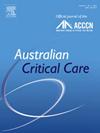Evaluation of the delivery of an intensive care nursing course during the COVID-19 pandemic and beyond: A cross-sectional study
IF 2.7
3区 医学
Q2 CRITICAL CARE MEDICINE
引用次数: 0
Abstract
Background
Monash University offers graduate study in Intensive Care Unit (ICU) nursing. Course delivery of graduate ICU nursing was significantly impacted by the COVID-19 pandemic, requiring adaptation from fully on-campus to fully online modes throughout 2020. From 2021, a flexible hybrid approach was implemented allowing students the choice of either mode, in addition to asynchronous online learning.
Aim/objective
The aim of this study was to evaluate the delivery of a graduate ICU nursing course during and after the COVID-19 pandemic.
Methods
A cross-sectional study using an anonymous online survey was administered to students from March 2020 to June 2023. Data items included delivery mode, content, learning activities, and clinical experience using a Likert scale and open-ended questions. Descriptive analysis of the sample was reported as mean or median depending on the distribution pattern. Free-text responses underwent thematic analysis.
Results
Thirteen cohorts of students (n = 948) yielded 539 responses, representing a 57% response rate. On-campus attendance increased significantly from 29.2% in 2021 to 44.4% in 2023, while online attendance has decreased to 48.9% from 65.8% in 2021. Overall, satisfaction with learning has risen for both on-campus and online students. On-campus satisfaction almost doubled from 23.3% in 2021 to 43.6% in 2023, while online satisfaction varied between 42.1% and 59.3% since 2021. Students appreciate the flexibility of the hybrid model but suggest separating the two modalities to enhance the student experience.
Conclusions
The COVID-19 pandemic necessitated innovative changes in course delivery, leading to the adoption of flexible learning modalities. While students appreciated the flexibility of the hybrid model, further efforts are required to seamlessly integrate both modalities during synchronous teaching.
COVID-19大流行期间及之后重症监护护理课程的评估:一项横断面研究
莫纳什大学提供重症监护病房(ICU)护理研究生学习。2019冠状病毒病(COVID-19)大流行对ICU护理研究生的课程交付产生了重大影响,需要在2020年从完全校内模式转向完全在线模式。从2021年开始,除了异步在线学习外,还实施了一种灵活的混合方法,允许学生选择任何一种模式。目的/目的本研究的目的是评估2019冠状病毒病大流行期间和之后研究生ICU护理课程的交付情况。方法在2020年3月至2023年6月期间对学生进行匿名在线调查,采用横断面研究。数据项目包括使用李克特量表和开放式问题的交付模式、内容、学习活动和临床经验。样本的描述性分析根据分布模式报告平均值或中位数。对自由文本回复进行专题分析。结果13组学生(n = 948)共获得539份问卷,回复率为57%。校内出勤率从2021年的29.2%大幅上升至2023年的44.4%,而在线出勤率从2021年的65.8%下降至48.9%。总体而言,在校学生和在线学生对学习的满意度都有所上升。自2021年以来,校园满意度几乎翻了一番,从2021年的23.3%增至2023年的43.6%,而在线满意度在42.1%至59.3%之间变化。学生们欣赏混合模式的灵活性,但建议将两种模式分开,以增强学生的体验。结论2019冠状病毒病(COVID-19)大流行要求对课程教学进行创新改革,采取灵活的学习方式。虽然学生们欣赏混合模式的灵活性,但在同步教学过程中,需要进一步努力将两种模式无缝集成。
本文章由计算机程序翻译,如有差异,请以英文原文为准。
求助全文
约1分钟内获得全文
求助全文
来源期刊

Australian Critical Care
NURSING-NURSING
CiteScore
4.90
自引率
9.10%
发文量
148
审稿时长
>12 weeks
期刊介绍:
Australian Critical Care is the official journal of the Australian College of Critical Care Nurses (ACCCN). It is a bi-monthly peer-reviewed journal, providing clinically relevant research, reviews and articles of interest to the critical care community. Australian Critical Care publishes peer-reviewed scholarly papers that report research findings, research-based reviews, discussion papers and commentaries which are of interest to an international readership of critical care practitioners, educators, administrators and researchers. Interprofessional articles are welcomed.
 求助内容:
求助内容: 应助结果提醒方式:
应助结果提醒方式:


